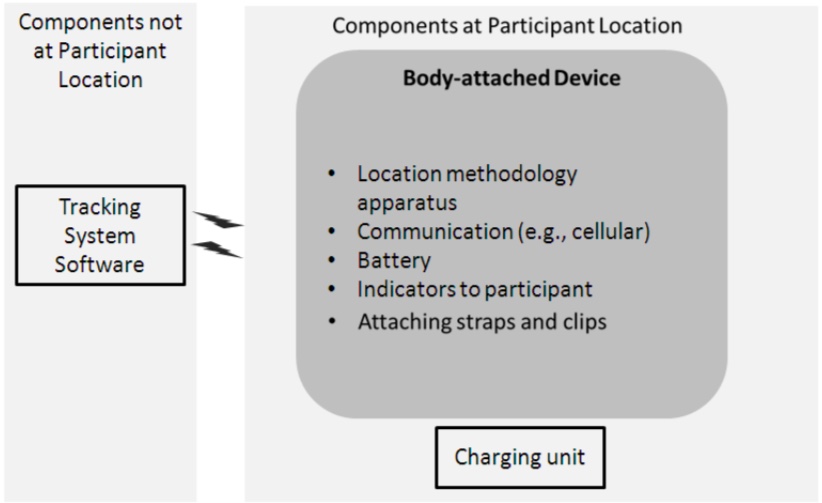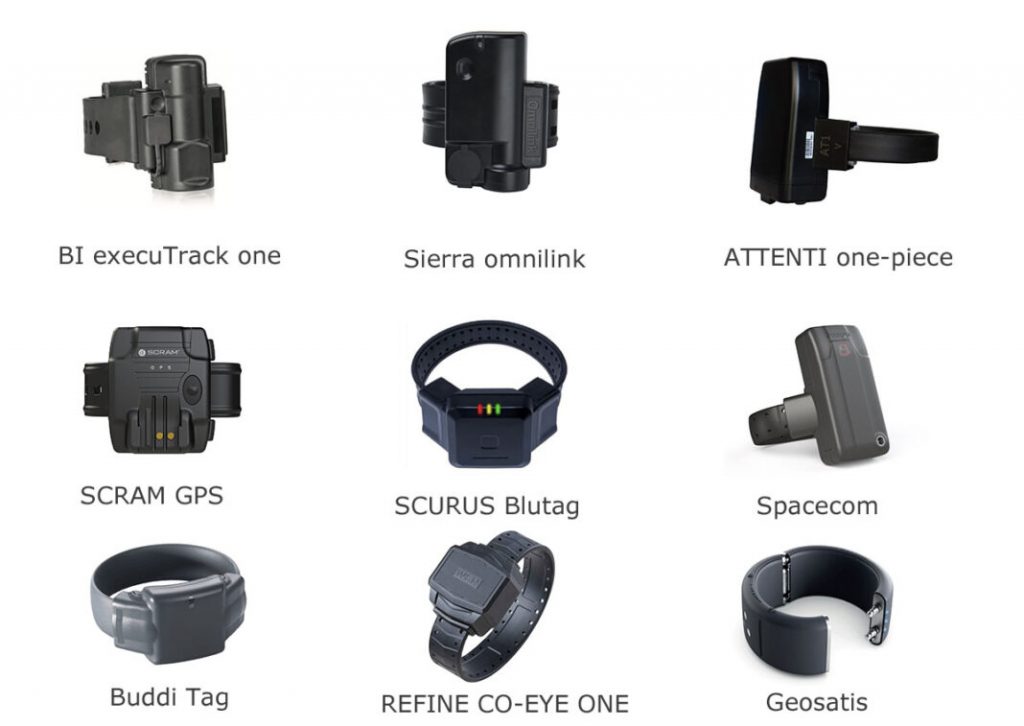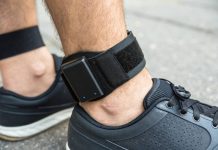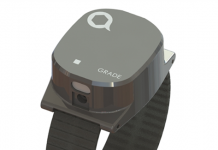In a one-piece model configuration, a body-attached device contains the location methodology apparatus, communication device, battery, attaching straps and clips, indicators to the participant, and casing.

In the body-attached device, the GPS receiver and bi-directional cellular communication transmitter/receiver are all integrated in single device. The communication between one-piece device and monitoring center relies on an inside SIM card and mobile phone coverage from the network provider.
The one-piece device should be secured round the ankle (except in extenuating circumstances where this is not possible) , and it is waterproof and cannot be removed without detection. An installation tool is used which simultaneously locks the strap around the monitored person’s ankle and activates the device in a single action. The signal of ankle bracelet emits to monitoring center includes the serial number of the device and its status (longitude and latitude coordinates, battery level, functionality, evidence of tampering and etc). The strap contains a fibre optic cable which transmits a light signal from one side of the device to the other which is interrupted if the strap is cut, creating a ‘tamper flag’ to alert the service provider that a tamper has occurred. The strap strength is also designed so that in the event of an emergency (such as the ankle bracelet becoming attached to machinery) a clip failure would occur and the ankle bracelet would be released. Typically, the one-piece model needs to be charged for three hours a day at ankle body which limits the movement of the person during that time.
One-piece model of ankle monitor is tightly connected with GPS technology. In 1973, the idea of a Global Positioning System, initially dubbed NAVSTAR, was developed by the United States Department of Defense. Originally, the technology was intended solely for military personnel and transportation units to obtain their location. Five years later, in 1978, the first four GPS satellites were launched into space by the U.S. Department of Defense. GPS did not reach full operational capacity until July 17, 1995, because a minimum of 24 satellites are needed to provide full coverage. In 1998, Vice President Al Gore announced a plan to make the GPS satellites transmit two additional signals to be free used for civilian (non-military) applications, GPS is rapidly becoming an integral part of mobile devices.

In 1998, Advanced Business Systems introduced “ABS Com Trak,” informally referred to as “The Bag,” a black nylon case containing a GPS receiver, cellular phone, computer, and battery. That year Pro Tech Monitoring (acquired by Attenti later) introduced their “SMART” system, containing similar components, in a metal and plastic box, known informally as “The Box.” Thus began the increasingly popular use of one-piece model which accounted for about 75% of U.S. monitoring units in 2020. Of course, whatever one-piece model or two-piece model, are all GPS-inside now.
Today, the mainstream vendors of one-piece model in market include BI (US), SCRAM system (US), Attenti (Israeli), Sierra wireless(US), Securus (US), Buddi (UK), REFINE (China), Geosatis (Switzerland), Spacecom(Brazil) and etc.

The pros and cons of one-piece model products can be concluded as below.
PROS:
- Simplistic configuration for usage, just one device attached at the ankle.
- Compared to two-piece model, there is no alarms because clients may forget to bring the tracker of the two-piece and causes the person to be out of sight.
- Especially it’s idealistic for high-risk offender monitoring.
Cons:
- The size of the one-piece model is considered as a burden for wearer, too bulky and too heavy.
- Too much clean, disinfection and refurbishment works and costs of two-piece model for hygiene safety in recycle-usage.
- The one-piece model needs to be charged for three hours a day at wear’s body, which is uncomfortable because of generating heat or hot on person’s skin and potential risk of battery fired.
- The short battery life of one-piece model limited the movements of wearer and raised more alarms of device dead in regular.















